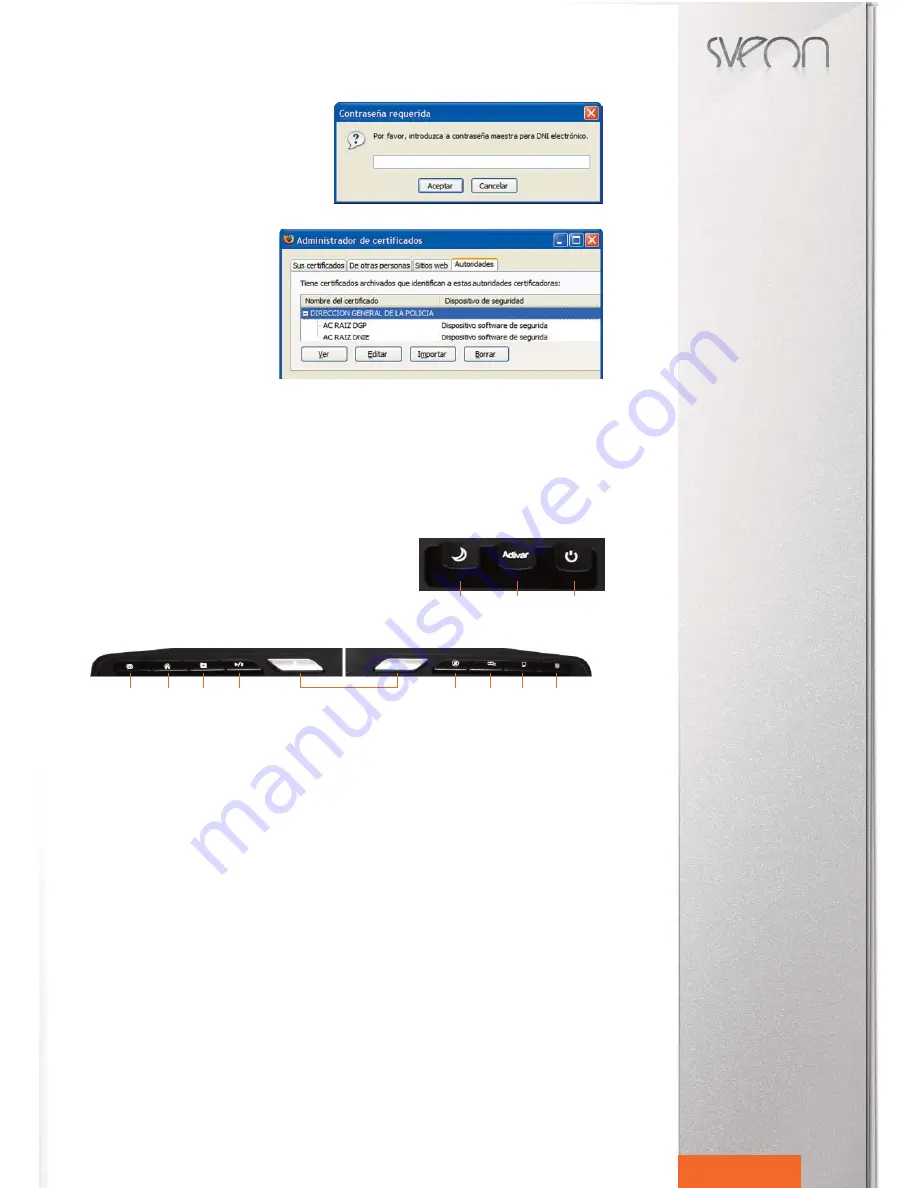
SCT020 User Guide
Index
1.Welcome
2.Features
3.Technical Specifications
4.System requirements
5.Content
6.Hardware
7.Installation
7.1 Driver installation for Smart card reader
7.2 Driver installation for DNIe
8.Multimedia keyboard
9.Keyboard
9.1 Key location
9.2 Special functions
9.3 Numeric pad
10.FAQs
11.Warning: Disposal of waste batteries
15
English
Step 3. When the PKCS#11 DNIe module is properly ins-
talled, you are able to view the DNIe certificates. Open the
Mozilla/Firefox navigator and go to Tools menu / Options
/ Advanced / View certificates. The DNie PIN will be re-
quired, please write it and go to “Options” section. Then
press on “View Certifiates” and in “Your Certificates” tab to
find your certificates:
- Certificate of Authentication
- Certifiate of signature
Step 4. In “Authorities” tab you will be able to
view the AC DNIE 00X certificate and the AC
RAIZ DNIE root certificate.
Step 5. If you have completed sucessfully all the previous steps and you can find the certificates, the PKCS#11 module
and Firefox root certificate are properly installed.
8. Multimedia keyboard
The keyboard includes 10 multimedia keys with the following functions:
1.Press to open Microsoft Outlook application of the email software installed in your computer.
2.Press to open the Internet explorer.
3.Press to open the Favourite links on Internet.
4.Press to play/pause a playback
5.Press + or - to increase or decrease the volume.
6.Press to enable mute function.
7.Press to open the multimedia player software.
8.Press to open My Computer menu.
9.Press to display the calculator.
10.Press to enable the Standby option.
11.Press to disable the Standby option.
12.Press to turn off the computer.
9. Keyboard
This guide is based on the SCT020 keyboard with 105 spanish keys. The setup in other languages may change the key
configuration.
9.1 Key location
The keyboard can be divided in different parts:
Top. It includes the numeric keys (1-0) and the special functions included in the numeric keys. To write these special func-
tions you can use Shift button (to write the second character) or Alt GR (to write the third character). In
addition, this bar includes a key in the left with the symbols º, ª and the bar. In the right, you can find different grammar
symbols and the keys of back or delete.
Middle. This part include the spanish alphabet keys. The keyboard includes 27 letteres in three lines, 8 grammar keys and
different writting control keys: tab, uppercase, uppercase lock and Enter.
Down. Here you can find three control keys (Control, Windows and Alt), the space bar and, in the right, four control keys
(AltGR, Win, Menu and Ctlr).
9.2 Special functions
Esc or scape:
Press to stop or exit a current function or to close a window.
Impr Pant:
Press to make screen shots. If you press it alone it saves the whole screen image. If you press it together with
Alt key, it only captures the current window.
Bloq Despl or Scroll Look:
Under MS DOS, this key works like the mouse scroll pressing together with the arrow but-
tons up and down.Actually it can be used to change the CPU when you are using a KVM adaptor.
Pause or Inter:
In some programs (specially under MSDOS) this button stops the current function.
Tab:
This key uses to be identified with two arrows. Press it in a editing program to move the highlight. It can be used to
change between different fields in database programs; if you pressit together with Shift key, it moves the higlight to the
left.
Uppercase lock:
Press to write always in uppercase mode; press again to disable this option. This button doesn’t affect
to the rest of keys with double function.
Shift
: Press to write a letter in uppercase mode. This key also write the second character in a key (the one located in the
top of the key, above the main character).
ctrl or Control:
This key is mainly used together with other keys like the function keys (F1 a F12) or with alphabetical keys
to enable different functions.
1
2
3
4
5
6
7
8
9
10
11
12
Содержание SCT020
Страница 1: ...Manual de usuario 2 User Guide 10...

















